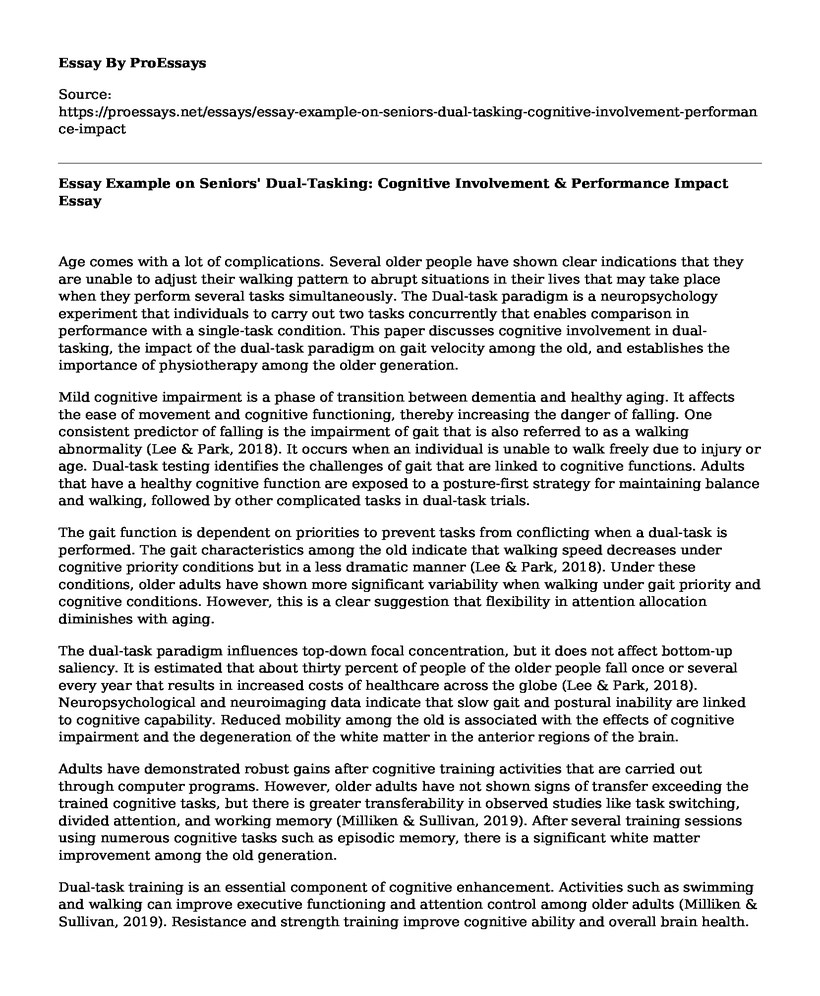Age comes with a lot of complications. Several older people have shown clear indications that they are unable to adjust their walking pattern to abrupt situations in their lives that may take place when they perform several tasks simultaneously. The Dual-task paradigm is a neuropsychology experiment that individuals to carry out two tasks concurrently that enables comparison in performance with a single-task condition. This paper discusses cognitive involvement in dual-tasking, the impact of the dual-task paradigm on gait velocity among the old, and establishes the importance of physiotherapy among the older generation.
Mild cognitive impairment is a phase of transition between dementia and healthy aging. It affects the ease of movement and cognitive functioning, thereby increasing the danger of falling. One consistent predictor of falling is the impairment of gait that is also referred to as a walking abnormality (Lee & Park, 2018). It occurs when an individual is unable to walk freely due to injury or age. Dual-task testing identifies the challenges of gait that are linked to cognitive functions. Adults that have a healthy cognitive function are exposed to a posture-first strategy for maintaining balance and walking, followed by other complicated tasks in dual-task trials.
The gait function is dependent on priorities to prevent tasks from conflicting when a dual-task is performed. The gait characteristics among the old indicate that walking speed decreases under cognitive priority conditions but in a less dramatic manner (Lee & Park, 2018). Under these conditions, older adults have shown more significant variability when walking under gait priority and cognitive conditions. However, this is a clear suggestion that flexibility in attention allocation diminishes with aging.
The dual-task paradigm influences top-down focal concentration, but it does not affect bottom-up saliency. It is estimated that about thirty percent of people of the older people fall once or several every year that results in increased costs of healthcare across the globe (Lee & Park, 2018). Neuropsychological and neuroimaging data indicate that slow gait and postural inability are linked to cognitive capability. Reduced mobility among the old is associated with the effects of cognitive impairment and the degeneration of the white matter in the anterior regions of the brain.
Adults have demonstrated robust gains after cognitive training activities that are carried out through computer programs. However, older adults have not shown signs of transfer exceeding the trained cognitive tasks, but there is greater transferability in observed studies like task switching, divided attention, and working memory (Milliken & Sullivan, 2019). After several training sessions using numerous cognitive tasks such as episodic memory, there is a significant white matter improvement among the old generation.
Dual-task training is an essential component of cognitive enhancement. Activities such as swimming and walking can improve executive functioning and attention control among older adults (Milliken & Sullivan, 2019). Resistance and strength training improve cognitive ability and overall brain health. The neuro-imaging practice has revealed that the functional connectivity and the health of the white matter tracts that lie between the brain regions are age-sensitive.
Conclusion
In conclusion, cognitive impairment among the old causes slow gait and a postural inability among the elderly. Such patients experience difficulties in walking and movement of body parts. However, these cases can be reduced through continuous dual-task training that enhances brain activity and body movement. Activities that improve dual-task performance include swimming and walking that have an overall impact on the strength of the brain in coordinating body movement.
References
Lee, J & Park, S. (2018). Effects of a priority-based dual-task on gait velocity and variability in older adults with mild cognitive impairment. Journal of Exercise Rehabilitation 2018; 14(6): 993-997. DOI: https://doi.org/10.12965/jer.1836402.201
Milliken, L. & Sullivan, N. (2019). Evidence to Support Improved Outcomes for Older Adults From Dual-Task Training Through Interprofessional Collaboration. Retrieved from https://pubs.asha.org/doi/10.1044/2018_PERS-SIG2-2018-0003.
Cite this page
Essay Example on Seniors' Dual-Tasking: Cognitive Involvement & Performance Impact. (2023, May 23). Retrieved from https://proessays.net/essays/essay-example-on-seniors-dual-tasking-cognitive-involvement-performance-impact
If you are the original author of this essay and no longer wish to have it published on the ProEssays website, please click below to request its removal:
- Psychiatric Disorders: Reflection Questions
- Annotated Bibliography: Autism Spectrum Disorder
- Research Paper on Managing Stress: Emergency Care Nursing Professionals
- Essay Example on Schizophrenia Assessment: Delusion, Hallucination & More
- Essay Sample on Psychoanalytic Therapy: Unlocking Unconscious Influences to Improve Well-Being
- Essay Example on Max Weber's Theory of Class: Ownership & Social Divisions
- Free Essay Example: Young People Need Fulfillment of Basic Needs in Classroom







